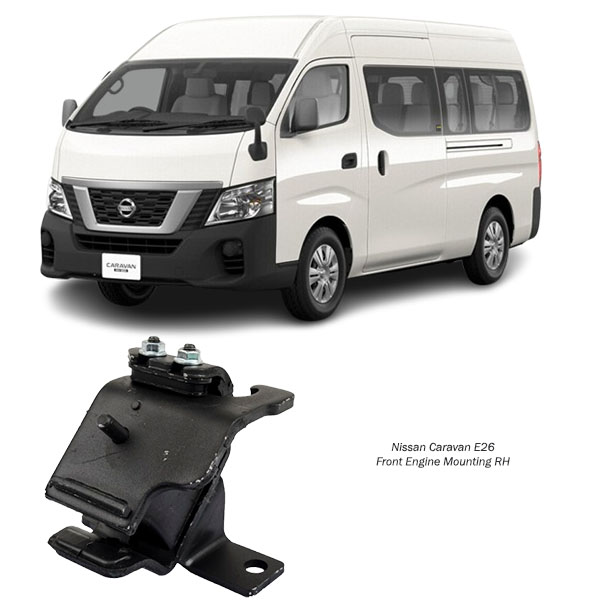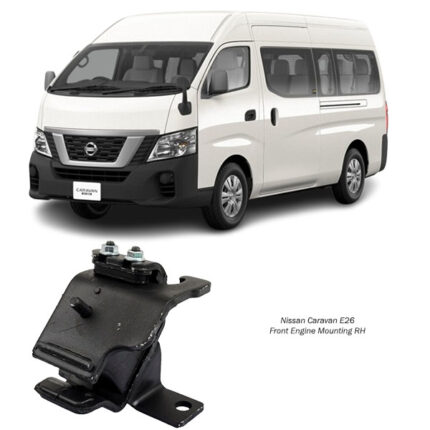Get Nissan Caravan E26 Front Engine Mounting RH 11210-3XN1A in Kenya
When we talk about engine performance, our minds often go to horsepower, torque, fuel efficiency, or even sound. But there’s one part—quiet, unnoticed, yet vital—that ensures the engine runs safely and smoothly within the engine bay: the Front Engine Mounting RH, or the right-hand engine mount.
This component, although small in size, plays a big role in maintaining engine positioning, reducing vibration, and ensuring overall driving comfort. In this article, we’ll explore everything you need to know about this part—what it does, how it works, signs of wear, and why it’s essential for long-term engine health.
📘 What Is the Front Engine Mounting RH?
The Front Engine Mounting RH is a structural piece that secures the engine on the right-hand (RH) side of the engine bay. Its main function is to hold the engine in position, absorb vibrations, and dampen movement caused by engine torque and road shocks.
Typically, this mount includes:
-
A metal bracket attached to the engine or chassis
-
A rubber or hydraulic core to absorb vibration
-
Mounting bolts that fasten the part securely in place
This mount works alongside other engine mounts (like the LH or rear mount) to provide multi-point stability and isolation.
⚙️ How It Works
During engine operation, there’s constant movement and vibration—especially when starting, accelerating, braking, or shifting gears. The engine rocks and twists slightly under torque, and without proper support, this movement would transfer directly to the vehicle’s frame, causing noise, vibration, and instability.
The Front Engine Mounting RH functions by:
-
Securing one side of the engine, allowing controlled movement in multiple directions
-
Isolating vibrations from the engine before they reach the cabin
-
Maintaining alignment between the engine and other drivetrain components
-
Supporting dynamic loads, especially during gear shifts or hard acceleration
This balance of strength and flexibility ensures smooth performance while protecting surrounding systems.
🧱 Types of Engine Mounts
The RH engine mount, like its LH counterpart, can be constructed using different technologies depending on design and performance needs:
1. Rubber Engine Mounts
The most common type, featuring a rubber core that absorbs engine vibrations.
-
Pros: Simple, affordable, low maintenance
-
Cons: Rubber wears out over time, especially with exposure to heat and oil
2. Hydraulic Engine Mounts
These include a fluid-filled chamber inside the rubber to enhance vibration damping.
-
Pros: Smoother ride, better vibration absorption
-
Cons: Can leak fluid, slightly more expensive
3. Electronic/Active Mounts
High-tech mounts that adapt to engine RPM and driving conditions using sensors and actuators.
-
Pros: Superior vibration control under all conditions
-
Cons: Expensive, complex, rare in standard configurations
🤔 Why the RH Mount Is Important
While all engine mounts serve a similar function, the RH mount often bears specific loads depending on engine layout and accessory placement. Its position may place it close to:
-
The transmission housing
-
The intake or turbo system
-
Suspension strut towers or crossmembers
As a result, it plays a critical role in balancing lateral forces and controlling engine tilt during movement.
🛑 Signs of a Failing RH Engine Mount
Over time, engine mounts wear down due to constant exposure to heat, engine vibrations, road impacts, and age. A failing RH engine mount can lead to several noticeable symptoms:
1. 🎯 Excessive Engine Movement
One of the first signs—if the engine rocks excessively or shifts during acceleration or braking, it could be due to a weakened RH mount.
2. 🗯️ Vibrations in the Cabin
Increased vibration felt through the steering wheel, floorboard, or pedals is often linked to a degraded engine mount that’s no longer absorbing movement effectively.
3. 🔊 Clunking or Banging Sounds
A loose or broken mount can allow the engine to knock against the chassis or other components, producing metallic clunks or bangs during motion.
4. 🧭 Misalignment of Components
Hoses, wiring, or even the exhaust system may become strained if the engine shifts position due to a damaged mount.
5. 👀 Visible Damage
Physical inspection may reveal cracked rubber, broken brackets, or signs of hydraulic leakage (in fluid-filled mounts).
🔁 When Should It Be Replaced?
There’s no fixed expiration date for engine mounts, but common replacement intervals range from 60,000 to 100,000 kilometers, depending on driving conditions and maintenance habits.
Replace the RH mount when:
-
Symptoms of failure are evident
-
Other mounts are being replaced (it’s wise to do them together)
-
Major engine or transmission work is being carried out
-
Visible damage is observed during inspections
Early replacement helps prevent secondary damage to the drivetrain and surrounding components.
🔧 Replacing the RH Engine Mount: What’s Involved
Replacement of the front engine mount RH is a technical task requiring careful support of the engine during the process. Here’s an outline:
-
Lift and support the vehicle safely.
-
Support the engine using a jack and block or an overhead support bar.
-
Remove any components blocking access to the RH mount (battery tray, intake piping, etc.).
-
Unbolt the old mount from the engine and chassis.
-
Install the new mount, aligning it carefully and torquing bolts to specification.
-
Lower the engine and reattach any removed components.
-
Test for unusual vibration or movement during idle and drive.
A professional installation ensures safety and correct alignment, especially for mounts exposed to dynamic forces.
🛠️ Maintenance Tips for Engine Mount Longevity
Engine mounts are built to last, but good habits can help maximize their lifespan:
✅ Routine Visual Checks
During regular maintenance, check for cracks in rubber, signs of corrosion, or fluid leaks in hydraulic mounts.
✅ Mind the Heat
Overheating engines can accelerate rubber degradation. Keeping the engine cooling system in check indirectly helps protect your mounts.
✅ Avoid Aggressive Driving
Sudden acceleration, harsh gear changes, and rough terrain can stress engine mounts more than usual.
✅ Listen for Noises
Early detection of clunks or vibrations can prevent more expensive damage later.
🧠 The Role in Overall Vehicle Dynamics
It might seem like just another part, but the RH engine mount is a key component in balancing the engine’s load, especially under torque. A well-functioning mount keeps:
-
Gear shifts smooth
-
Cabin vibration low
-
The engine in its designed alignment
-
Strain off sensitive engine systems and electronics
If neglected, even a minor mount issue can evolve into larger problems involving engine misalignment, worn drivetrain components, or torn hoses and wiring.
📌 Conclusion
The Front Engine Mounting RH is a small but mighty part in the engine bay, ensuring everything stays firmly in place while driving remains smooth and controlled. It absorbs stress, dampens vibrations, and protects the overall integrity of the engine and surrounding components.
Understanding its role, recognizing signs of wear, and replacing it when needed can help maintain a smoother, safer, and longer-lasting driving experience. In the world of engine components, this mount may not make a lot of noise—but it certainly keeps things quiet and under control.
Follow us on Facebook for more parts.





Reviews
Clear filtersThere are no reviews yet.